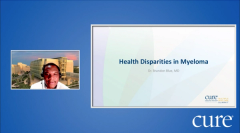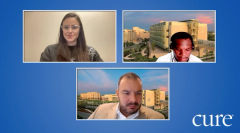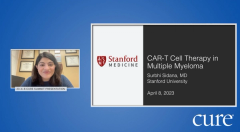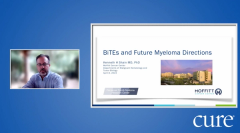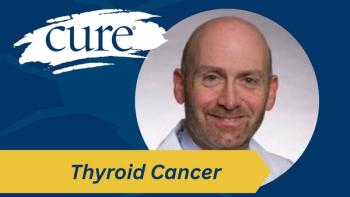
Educated Patient® Multiple Myeloma Summit Newly-Diagnosed Updates Presentation: April 8, 2023
Watch Dr. Dickran Kazandjian, from Miami Health System, discuss updates in newly diagnosed disease during the CURE Educated Patient Multiple Myeloma Summit.
Episodes in this series

Since the recent introduction of new agents and novel combinations of drugs to treat multiple myeloma, patients newly diagnosed with the disease are living longer and are benefitting from three- and even four-drug therapies, an expert explained.
“I think things have changed,” Dr. Dickran Kazandjian, professor of medicine in the Division of Melanoma and associate director of clinical trials research at Sylvester Myeloma Institute and University of Miami Miller School of Medicine, told CURE®. “The whole landscape for myeloma has improved a lot in the past few decades, where patients are living 20-plus years, whereas in the beginning, survivals were short, then maybe the second cancer didn't even have time to pop its ugly head out. But now people are living long enough where we have to take (second-, third- and fourth-line therapies) into consideration.”
Kazandjian discussed the treatment of patients with newly diagnosed multiple myeloma during the CURE Educated Patient® Multiple Myeloma Summit.
“I think it’s incredibly important (to know about this) because your first shot at treatment is always your best shot in gaining long-term clinical benefit and, ultimately, survival,” he told CURE.
Treating a Spectrum of Disease
Kazandjian explained that multiple myeloma is a cancer of the plasma cell, a type of white blood cells in blood, and has several precursor conditions specific to the disease.
“It’s really a spectrum of disease that includes monoclonal gammopathy of undetermined significance, smoldering multiple myeloma and then multiple myeloma,” he said during the presentation. “What really differentiates multiple myeloma is when these malignant plasma cells, or myeloma cells, actually cause organ damage. That organ damage is known with the acronym CRAB, which stands for C, hypercalcemia (higher than normal levels of calcium in the blood); R, renal or kidney disease; A for anemia; and B for bone destruction.”
Treatment for newly diagnosed
Combination induction therapy typically includes Velcade (bortezomib), Revlimid (lenalidomide) and dexamethasone (VRD), or Kyprolis (carfilzomib), Revlimid and dexamethasone (KRD). These two regimens can be given with or without anti-CD38 monoclonal antibodies.
After combination therapy, patients may receive a high dose of melphalan, a chemotherapy drug, with stem cell support, followed by consolidation therapy and then maintenance therapy, according to the presentation.
Kazandjian gave an example of a possible treatment algorithm for patients with newly diagnosed multiple myeloma, which would include six to 10 cycles of combination induction therapy. After four of those cycles, patients who are potentially eligible for stem cell transplant will receive a stem cell harvest, which is when a patient’s blood is temporarily removed from their body, stem cells are separated from it and then the blood is returned to the body.
Upon completion of combination induction therapy, a
“What really MRD is, is like putting on an even finer lens on a microscope, meaning you have a regular lens and you don't see any myeloma cells. But what if you put on a more powerful lens? And that's what really MRD testing is,” Kazandjian said.
He added that many studies have demonstrated that MRD negativity is linked with the long-term outcome of progression-free survival, which is “basically how long it takes for the myeloma to come back or cause the patient to die,” he explained. MRD negativity may also be associated with overall survival, which is how long a patient lives regardless of what is happening with myeloma.
Although stem cell support and high-dose chemotherapy was the first treatment that changed the lives of patients with newly diagnosed multiple myeloma, but the availability of novel therapies that are well tolerated and are associated with high efficacy rates may open the doors to new treatment trajectories, Kazandjian said in an interview with CURE.
“Even though traditionally, high-dose chemo with stem cell support has been the nucleus and all the other treatments planned around it, I think it's time to approach it differently, where high-dose melphalan is still important, but just another tool in the mechanic’s toolbox,” Kazandjian told CURE. “To transplant everyone without evaluating response and how patients are doing is maybe not the right way to approach it. And I think stem cell support can be reserved for those who may need it. And those who may not need it, don't need to receive it because there's potentially long-term consequences.”
Looking to the Future of Treatment
There is a new era of novel quadruplet therapies including Darzalex (daratumumab). In the GRIFFIN study, patients with newly diagnosed multiple myeloma were assigned VRD with or without Darzalex. The findings demonstrated that Darzalex improved the response rate, the rates of MRD negativity and progression-free survival.
The MANHATTAN trial also assessed quadruplet therapy with Darzalex but with the KRD. Results showed that patients assigned the four-drug regimen had high levels of attaining MRD negativity.
Sarclisa (isatuximab) is another option as a fourth drug in a KRD regimen, which has also demonstrated high rates of MRD in trials like the GMMG-CONCEPT trial, according to the presentation. Of note, patients in this trial had high-risk, newly diagnosed multiple myeloma.
In fact, Kazandjian and his colleagues are currently conducting the ADVANCE study, which includes 462 patients with newly diagnosed multiple myeloma. Patients are assigned to receive either four cycles of KRD or four cycles of Darzalex plus KRD.
Although these treatment options often focus on fit patients, studies have been conducted in less fit patients with newly diagnosed multiple myeloma like the MAIA trial. The trial aimed to compare the addition of Darzalex to Revlimid and dexamethasone with Revlimid and dexamethasone. The three-drug regimen increased the amount of time for the myeloma to return compared with the combination therapy.
“It’s beneficial in terms of (progression-free survival), but also in terms of how long patients live,” Kazandjian said.
Other studies in progress for patients with newly diagnosed multiple myeloma include those looking into CAR-T cell therapies and other immunotherapies.
“It is really exciting time for targeted immunotherapy, with CAR-T and bispecific antibodies showing great results,” Kazandjian said during the presentation. “Moving forward, strategies will have to aim to incorporate immunotherapy in the upfront setting, even possibly abrogating the need for transplant.”
For more news on cancer updates, research and education, don’t forget to

